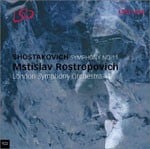Symphony No. 11 in G minor 'The Year 1905'
op. 103 (1957)3(III=picc).3(III=corA).3(III=bcl).3(III=dbn)-4.3.3.1-timp.perc:tgl/SD/BD/cyms/tam-t/t.bells/xyl-2-4hp-cel-strings(16-20.14-18.12-16.10-14.10-12)
Abbreviations (PDF)
VAAP
1.Palace Square 2.Ninth of January 3.Eternal Memory 4.Tocsin
Shostakovich’s Eleventh Symphony has long been one of his most controversial. To some, including many Russians, it is a sad example of his falling-off, a caving-in to the ideological demands of socialist-realism with its reliance on the quotation of well-known 19th century revolutionary melodies (several of which Shostakovich had previously used in patriotic film- and theatre-scores) and its cinematic use of rhetoric borrowed from Musorgsky’s opera ‘Boris Godunov’ and elsewhere. To others however this symphony is a great and double-edged work. Shostakovich’s contemporary the great poet Anna Akhmatova described the effect of the quoted songs as like ‘white birds flying against a black sky’.
The piece was written as part of the official celebrations to mark the Fortieth Anniversary of the October Revolution in 1917 and in its pictorial content it commemorates the massacre of Bloody Sunday that formed part of the opening of the 1905 Revolution. But some have suggested that what Shostakovich really had in mind was the cruel Soviet repression of the Hungarian uprising in 1956. Certainly the use of the old revolutionary songs cannot avoid being double-edged, whether the composer intended it or not (and presumably he did), for their words all speak of the cruelty of tyrants, of brutal repression and the execution of innocent prisoners, and of the yearning for freedom and the violent fate that awaits those rulers who have oppressed the people for too long.
Shostakovich also draws material for this symphony from a revolutionary chorus of his own, from his op.88 set of a capella choruses to words by revolutionary poets. Throughout this symphony, from the slow opening movement depicting St.Petersburg’s Palace Square before dawn on Bloody Sunday, through the yearning cries of the protesters in the second movement, the memorial music of the third movement and the anger and anguish of the finale, we hear over and over again the orchestra reiterating the opening notes of the chorus that set the words: ‘Bare your heads!’ The implication of communal and personal shame is inescapable.
Note by Gerard McBurney

LSO, cond. Mstislav Rostropovich
LSO Live LSO0030
